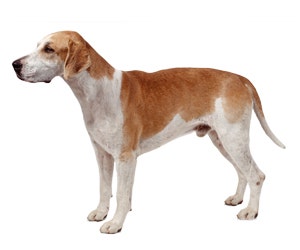English Foxhound
-
Overview
Upon seeing one of these dogs, you might think to yourself, "Look at that big Beagle!" But there are actually several differences between the English Foxhound and the Beagle, other than size. These larger dogs stand about 2 feet tall and weigh in between 50 and 75 pounds. The Foxhound is a little more of a gentleman, bred to hunt foxes and to lead the pack into a hunt in the English countryside. They are sturdy and large boned, known for being slightly stockier than their lithe American cousin, the American Foxhound.
-
Personality
Because they were bred to hunt in packs, English Foxhounds enjoy the entertainment and companionship that comes from living with another dog. They flourish in homes where they have a canine companion to entertain them indoors or out because it helps prevent them from seeking out their own forms of entertainment, like digging, destroying furniture and howling at the neighbors. English Foxhounds are athletic dogs with plenty of endurance to track through the field for hours on end. They need plenty of exercise, like running or jogging, in order to stay happy and fit. English Foxhounds are gentle and relatively friendly, but they are not overly affectionate. Without socialization, they will not be especially outgoing or eager to meet strange humans, so they will benefit from making plenty of human and canine friends.
-
Coat Care
English Foxhounds have tricolor, short, smooth coats. Their coat is seen in the recognizable black, tan and white pattern, usually with a black saddle, white markings around the underbelly and the tops of the legs, and tan around the tail and head. Their tails are long and alert, usually with a white tip on the end and some looser hair toward the tip.

Brushing the coat weekly with a rubber bristle brush will remove dead hairs and help keep the English Foxhound's coat clean.
They do not need to be bathed very often, but if they are smelly, it's a clear indication that it's bath time.
Clipping or trimming your dog’s coat is far easier than you would ever imagine. With the right clipper, trimmer and scissors, giving your dog a haircut is easy on your wallet and your schedule.
Most dogs with short coats generally require occasional trims and tidying up in areas of excessive hair growth with trimmers or blunt scissors. It's always wise to take a dog for a short walk or exercise to calm them down before trimming. Remember to brush the coat first to remove tangles and mats. Use a trimmer or a scissors to even out areas around the tail, paws, sanitary areas and chest, as needed. When finished, the coat should lay flat and smooth against the body of most short-haired dogs.
Many dog owners are apprehensive about trimming their dog’s nails because they are nervous about cutting into the quick. But with the right conditioning and careful cutting, nail clipping can be a simple, stress-free activity for you and your dog.
Provide your dog with plenty of positive reinforcement and even treats to help associate nail clipping with a positive experience. As you start to clip, gently press on your dog’s paws to help him become accustomed to the feeling of having his nails clipped. Then, work gradually, shaving down just a thin portion of the nail at first to make sure you don’t reach the quick. Clip one nail, reward your dog with a treat, and stop to give him some positive reinforcement before moving on. Gradually increase the number of nails you clip in one sitting to help your dog get used to the process. Never trim extremely long nails down to a short nail in one sitting, because this is an excellent way to accidently quick the dog’s nail. Instead, work gradually, shaving small portions of your dog’s nails off each time.
You can tell if you’re getting close to the quick by the texture of your dog’s nail. The nail is hard closer to the surface and becomes softer as you get closer to the quick. If your dog’s nail starts to feel softer, that’s a good indication that you’re getting close to the quick.
Check their large, floppy ears weekly for infections and make sure to clean them gently if necessary.
Many owners do not realize how important it is to brush your pet’s teeth on a regular basis. Some dogs are prone to dental problems and sensitive teeth, especially small dogs with tiny teeth and dogs with special diets. These problems can be easily combatted with frequent brushing.
Cavities are rare with dogs but gum disease caused by tartar buildup is not, which is why they require regular brushing with toothpaste and a toothbrush formulated specifically for dogs. While daily brushing is ideal, doing so on a weekly basis will be a big help in avoiding the need to bring your dog to a veterinarian for a cleaning, which usually has to be done under sedation.

 India (English)
India (English)
 Middle East and Africa (English)
Middle East and Africa (English)
 South Africa (English)
South Africa (English)
 Australia (English)
Australia (English)
 Japan (日本語)
Japan (日本語)
 South East Asia (English)
South East Asia (English)
 Singapore (English)
Singapore (English)
 Europe (English)
Europe (English)
 United Kingdom (English)
United Kingdom (English)
 Argentina (Español)
Argentina (Español)
 Brazil (Portuguese)
Brazil (Portuguese)
 Colombia (Español)
Colombia (Español)
 Latin America (Español)
Latin America (Español)
 México (Español)
México (Español)
 Chile (Español)
Chile (Español)
 Peru (Español)
Peru (Español)
 Canada (English)
Canada (English)

